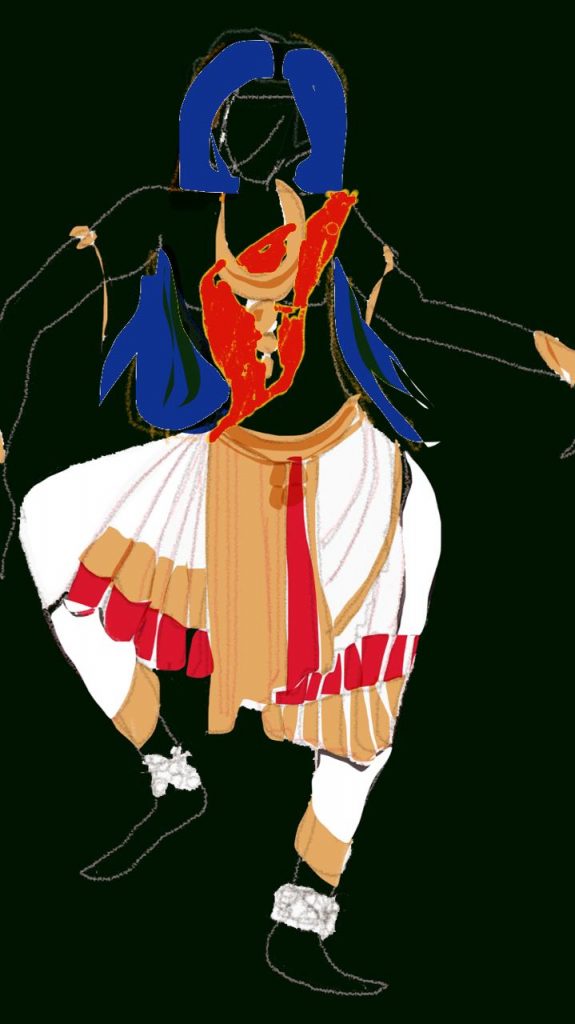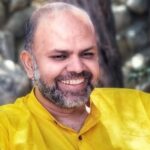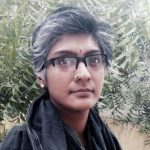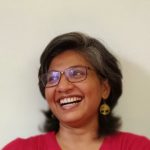Mahabharata Immersion (MI) is an offering from Ritambhara, an invitation to experiment with oneself, delve unto the depths of the invisible, the unarticulated and the disowned parts of ones self by working with the stories from the great epic. The following is a conversation between Gayatri Iyer and Raghu Ananthanarayanan, the creator of the MI, on the latest MI workshop that took place in Feb 2019.
Gayatri: I always start with this question when we discuss the Mahabharata Immersion, but how the 6th edition different from the earlier one?
Raghu: Well, despite having done the immersion so often, each time this space is explored it throws up something different. My understanding of every element of the immersion became much clearer since the time I have started writing a paper on the MI. Noa, who is a Jungian scholar, a dear friend and former MI participant, was fascinated with the parallels and we have had many discussions on the design principles of the MI and some of the methods Jung used.
While a lot of the steps of self-reflection that we follow in the MI are like Jung’s approach, there are also some critical differences. From the beginning, we emphasized the practice of sakhi and sAkshi bhAva i.e. looking at oneself from the compassion of a friend and from a deep meditative space. The interpretation of the self is kept aside.
Gayatri: How?
Raghu: You must keep in mind that in an MI we are enabling functional people to become the best they can be; we are not dealing with people needing therapy, which is what Jungian analysis focuses on. So, if a participant starts to interpret herself, I as a facilitator can ask her to stop and just observe rather than interpret. In any case the sakhi/ sAkshi bhAva precludes interpretation and promotes simple observation. It is the voice of the inner judge that introduces interpretations.
Gayatri: But all the participants must be quite new to inner process work etc. Did they all get it?
Raghu: We put them through exercises that helped them understand and acknowledge the inner voices. Many of them later remarked on how important the act of simple observation was in enabling them to get free of old patterns.
Gayatri: Were there any new inclusions from the faculty side?
Raghu: We have been inviting people who have matured in the facilitation process to be co-faculty in each MI. The underlying grammar remained the same as the earlier MIs, but this time the faculty members were more in the flow and took turns anchoring the sessions, participating and observing the groups. This movement of going in and out was seamless. I think it helped the participants feel more held, and it told them that we are human beings and we are on our own journey of self-discovery too.
Gayatri: As a head faculty and creator of this program what kind of preparation do you go through before the program?
Raghu: There are a few things that I do work on before the immersion-:
- I try and experience each of the elements of MI in my own practice. For e.g. the first part of the immersion is to unfreeze the body structures through rasa exploration. As I do my asana practice, I am concentrating on my body and trying to access a subtler awareness to understand what is happening.
- I do a lot of reflective writing and art work to keep looking at my own archetypal energies. I also go back to brush up on the numerous Mahabharata stories.
- I am trying to understand how each rasa gets lodged in my body, the patterns it creates and so on.
Gayatri: For e.g. you are triggered by something and get in touch with rOudram, so what do you do?
Raghu: I try and step back and watch the habitual patterns I create when I experience rOudram. When I do this introspection before an MI, I also look at which of the archetypes I am reflecting. In a way, I am sensitizing myself to go into the immersion.
Gayatri: Did you discover anything before this immersion?
Raghu: As I was working on the paper, I could see the entire process unfolding like a series of petals of a flower. Working with the body or annamaya mandala flowing into understanding archetypal energies in the prANAmaya mandala and then naturally enabling me to understand how I relate with myself and with my world. The nature of exchange was understood much more clearly this time.
Gayatri: Now I will come to my favorite part; which characters were explored?
Raghu Ahhh yes…this time the first ones to be explored were Yudhishtra and Bhishma respectively. All the participants in these two groups were struggling with a few underlying notions of how to hold authority and how to hold leadership positions.
The scene enacted for Bhishma was the dialogue he had with Satyavati when she asks him to wed the widows of Vichitravirya i.e. Ambalika and Ambika to produce heirs to the throne of Hastinapur. But Bhishma refuses stating that his vow is never to marry.
The subtler question that people in the group kept coming back to was that ‘As an Indian today, if I get stuck in my traditions and get caught with it, I become a Bhishma.’ I end up holding certain values and theories with a lot of rigidity rather than look at the context. So, to start with; as an Indian, how can I be true to myself and what does Indianness mean to me now, how do I recreate this identity in a way that is contemporary without losing a connect with my tradition?’
Gayatri: It almost sounds like a dharmic war cry.
Raghu: Yes, it does because how do I discover a new bHUmi for myself, a new dharma to stand upon and fight for?
Gayatri: It is a very profound and tough question no?
Raghu: Absolutely, the person who articulated this was running an NGO, he had worked at the grass-root level in India. So, for him the questions “What is India? What does it mean to be an Indian today and in the world?” were very important. This struggle was not only his, it spoke a lot about the struggle of many others in different contexts.
For e.g. one of the participants was extremely concerned about the drug problem in Punjab, the complete breakdown of value structures due to various ways in which people in power have betrayed the trust placed on them. His question was, “As a young person, how can I find a way to act in that context so that dharma can be recreated?” The old structures are clearly not working, and our leaders are simply preying upon this decay too. This is where the question of how one holds a leadership position and authority was explored.
Gayatri: I am moved by the depth of this question.
Raghu: Of course, it is difficult, it is not a question to be answered intellectually, it is something that is answered through the way one chooses to live!
Gayatri: But this question seems to be an Arjuna type of exploration, wherein he is standing in the middle of all the chaos and asking the question
Raghu: See, at one level it is an Arjuna’s exploration with underpinnings of looking at the context but majorly, it explores the legitimacy of the ground or action. I am saying this, because the whole exploration of Yudhistra was set up in a leadership context. During the agnyAta vAsa, Bhima and Draupadi are enraged with Yudhishtra for not acting and fighting the Kauravas. They try their best to instigate Yudhishtra but he calmly responds saying that ‘it is not yet the time to act, but to gather our strength, create alliances and acquire weapons to prepare for the war with Kauravas ultimately.’

The group finally came up with the reflection that Yudhishtra needs to have a deep dialogue with Arjuna to understand where to act from. One of them actually said “I have to undergo Arjuna’s tapas. I must discover my femininity as well as answer deep philosophical questions before articulating a new dharma for myself.
Gayatri: What does femininity here mean?
Raghu: It means asking how can I look at the world in an inclusive way? not me versus the world. See, if I hold on to a very rigid masculine (not necessarily patriarchal) frame of looking at the world it would affect the way I act in the world.
The current forms of power are modeled on militaristic and colonial forms, which are essentially masculine. This is not helping the world at all. For any person concerned with the environment, social structures, poverty, this form of power is seen as the cause of the issues.
So, to design a new lens of power and leadership, I need to understand my current lens which is universally approved, almost taken for granted, and through which I am operating. This is what I am referring to as masculinity, and unless I get in touch with my feminine side and look at the world through that lens, how would I ever create a holistic dharma?
Gayatri: As you were explaining, I was feeling a sense of guilt because I feel I am also part of the problem responsible for the state of the environment, social structures etc. I just felt like sharing this.
Raghu: This is where the practice of sakhi bhAva and sAkshi bhAva come into play. Your sharing is coming from a sakhi bhAva, owning up to the fact that my actions contribute to the world’s problems. But the trap is that one falls into is getting into a mode of self-condemnation. Then all your energy is used up in beating yourself up rather than saying “Ok, now that I have discovered how I am part of the problem let me stop and ask how I can be part of the solution?”. This sorrowful discovery should energize you to look at what you can do.
Gayatri: Meaning?
Raghu: See, this is exactly the issue that one gets caught with: on the one side you are caught with the guilt saying you are holding on to traditions or ways of living which are not helping the new context to grow or are incompatible to the world around us. At the same time, you find that the new ways that are being deployed are not nurturing the earth, they are not holistic. But the other extreme i.e., to continue to wallow in the remorse is also useless.
The key is to not let the judge in you become your dominant lens. You encourage the friend in you who says ‘Yes, this is the reality and experiencing some regret is fine, but can I use this energy to redefine myself or my bHUmi? While I am open to learning from both ends, can I take a step to shape something meaningful for me and take the risk of shaping it?’
Gayatri: I like how you have used risk here.
Raghu: Yes, it requires courage to say no, the usual or traditional habitual ways are not serving me anymore and can I act in a different meaningful way? And to say can I discover a way that is meaningful to me and not follow another model borrowed from elsewhere however successful it looks.
Gayatri: I am struggling with these questions myself in my context, I keep going back to my old ways which have are not serving me or helping me grow. How can I find a new dharma or ground to act?
Raghu: These require very deep dialogues with oneself from a space of quietude of shAntam. A lot of participants agreed that one needs to continue a deep dialogue with oneself in order to dialogue with others. I cannot keep a dialogue in an external relationship going unless I do the same with myself no?
Gayatri. Yes true, but these questions come with no prescription, right?
Raghu. Of course, there is a sAdhana involved and commitment to walk on this path. These are not questions, but quests my dear.
Gayatri: The explorations of Yudhishta and Bhishma are so relevant for today’s context and anyone really looking for meaning in their life.
Raghu: Naturally. The participants are very authentic about their struggles in this self-reflective space it will therefore bring out powerful underlying themes.
Gayatri: But these paths or touching the depths of your struggles is not easy, didn’t some of them get scared?
Raghu: It is scary no doubt. For some who are committed to walking on this path it is a lifelong sAdhana. But if you think you can stand on the side dip your feet and pick up a few tricks from the Immersion then it is a very superficial exploration that would not help you creating a new dharma.

 Anoop is a student of Yoga, an entrepreneur, a coach and a father of two young boys. He has led successful leadership stints in both the corporate and non-for-profit sectors. On encountering the country’s water/farmer crises at close quarters, he decided to pause and examine the impact various ‘isms’ – capitalism, colonialism, etc., were having on us as individuals, families, the society and the environment at large. This quest led him to formally engage with traditional Indic knowledge systems while also learning from the latest advances in science – about our physical and mental wellbeing, importance of body and mind work in healing trauma and the urgent need for a conscious rebuilding of family / work / social structures if we have to thrive individually and collectively. Insights, frameworks and processes gleaned from these on-going studies, an anchorage in his own personal practice and his wide-ranging experiences is what Anoop brings to facilitation/coaching spaces in Ritambhara and his various professional engagements.
Anoop is a student of Yoga, an entrepreneur, a coach and a father of two young boys. He has led successful leadership stints in both the corporate and non-for-profit sectors. On encountering the country’s water/farmer crises at close quarters, he decided to pause and examine the impact various ‘isms’ – capitalism, colonialism, etc., were having on us as individuals, families, the society and the environment at large. This quest led him to formally engage with traditional Indic knowledge systems while also learning from the latest advances in science – about our physical and mental wellbeing, importance of body and mind work in healing trauma and the urgent need for a conscious rebuilding of family / work / social structures if we have to thrive individually and collectively. Insights, frameworks and processes gleaned from these on-going studies, an anchorage in his own personal practice and his wide-ranging experiences is what Anoop brings to facilitation/coaching spaces in Ritambhara and his various professional engagements.
 Priya is a Yoga therapist in the Krishnamacharya tradition. She adapts Reiki & energy work, Vedic chanting, life coaching & Ayurvedic practices in her healing spaces. She is committed to nurturing collectives that have the praxis of Yoga at their heart.
Priya is a Yoga therapist in the Krishnamacharya tradition. She adapts Reiki & energy work, Vedic chanting, life coaching & Ayurvedic practices in her healing spaces. She is committed to nurturing collectives that have the praxis of Yoga at their heart. Anisha has been on an exploration to understand herself through yoga for the last 15years which led her to teaching yoga, yoga therapy and inner work through yoga.
Anisha has been on an exploration to understand herself through yoga for the last 15years which led her to teaching yoga, yoga therapy and inner work through yoga. Apoorva chanced upon Yoga in her early 20s. A spark was lit within and there was no turning back. Her exploration led her to the Krishnamacharya tradition more than a decade ago. Curious about human behaviour and what drives it, she was thrilled when her search ended (and also began) when she first came upon the Yoga Sutra, which illuminated a path towards answering many questions that had been held for a long time.
Apoorva chanced upon Yoga in her early 20s. A spark was lit within and there was no turning back. Her exploration led her to the Krishnamacharya tradition more than a decade ago. Curious about human behaviour and what drives it, she was thrilled when her search ended (and also began) when she first came upon the Yoga Sutra, which illuminated a path towards answering many questions that had been held for a long time. Anita is a yoga teacher and therapist in the tradition of Sri.T.Krishnamacarya and Sri T.K.V. Desikachar, a Reiki practitioner and a Life Coach. She is also the founder of Vishoka, a center for learning Indic and energy-based frameworks for living and healing. Her deep concern for human suffering and the problems of unsustainable living kept her on the path of seeking an integrated approach to looking at life, living, learning and healing.
Anita is a yoga teacher and therapist in the tradition of Sri.T.Krishnamacarya and Sri T.K.V. Desikachar, a Reiki practitioner and a Life Coach. She is also the founder of Vishoka, a center for learning Indic and energy-based frameworks for living and healing. Her deep concern for human suffering and the problems of unsustainable living kept her on the path of seeking an integrated approach to looking at life, living, learning and healing. Ankit is a seeker in the wisdom traditions of India. The core of his work includes creating dialogic spaces where people can look within and see the connection between their inner and outer lives. Inspired by the likes of Gandhi, Aurobindo, Vivekananda and Guru Gobind his experiments in service took him back to his roots in Punjab where he is creating a community-led model of higher education which is open, inclusive and accessible for all. Ritambhara for him is a space for engaging in a community which is committed to a DHramic life. He anchors his work of learning and leadership in the Antaranga Yoga Sadhana and the humanistic wisdom of Mahabharata.
Ankit is a seeker in the wisdom traditions of India. The core of his work includes creating dialogic spaces where people can look within and see the connection between their inner and outer lives. Inspired by the likes of Gandhi, Aurobindo, Vivekananda and Guru Gobind his experiments in service took him back to his roots in Punjab where he is creating a community-led model of higher education which is open, inclusive and accessible for all. Ritambhara for him is a space for engaging in a community which is committed to a DHramic life. He anchors his work of learning and leadership in the Antaranga Yoga Sadhana and the humanistic wisdom of Mahabharata.